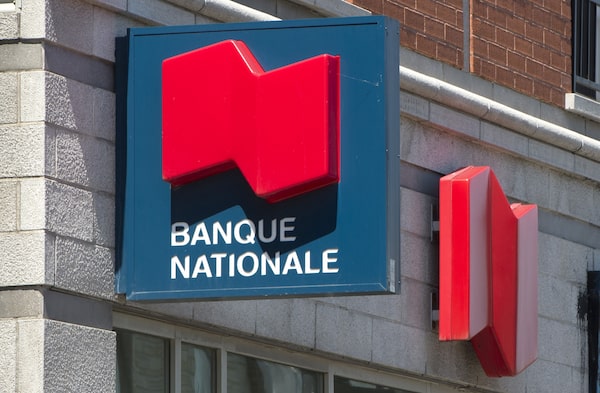
A National Bank sign on May 30, 2016 in Montreal.Paul Chiasson/The Canadian Press
National Bank of Canada NA-T has reversed its decision to cancel mortgage portability on existing customers.
The bank pulled its portability option last summer but news of it just hit the market last week. The backlash was swift and intense, given that the bank made no formal public communication of the change. Portability is a mortgage feature that allows customers to transfer their existing mortgage to a newly purchased property, allowing them keep the low interest rates they secured before the recent surge in borrowing costs.
“We wanted to clarify the confusion” following last week’s news, Tarek Naguib, National Bank’s vice-president of retail financing solutions, said Thursday in a phone interview.
He said the bank eliminated its portability option amid surging interest rates, essentially because it was too costly. At the time, the bank had allowed up to 180 days to port instead of the industry average of 60 to 90 days.
“We will reintroduce the portability feature, aligned with industry standards,” something the bank had always considered doing anyhow, Mr. Naguib said. The new portability feature will apply to current and new clients alike.
The bank said an announcement will be made this week.
Floating rate woes
It’s been a tense year for homeowners in floating-rate mortgages. They’ve watched their interest rates catapult 400 basis points in just nine months. (There are 100 basis points in a percentage point.)
To put that in perspective, imagine you got a $400,000 mortgage in February. At a typical variable rate of 1.45 per cent back then, your notional five-year interest cost would have been $26,495 – assuming rates didn’t change.
At today’s rates (5.45 per cent), again assuming static rates, that very same mortgage over five years would cost you a stunning $102,280 in interest, almost four times as much.
The sheer debt burden that today’s new mortgagors must bear is breathtaking. The tens of thousands of extra dollars that must now go toward interest – instead of goods and services – will profoundly slow our economy in 2023.
CALCULATOR: See how rising interest rates will affect the cost of your mortgage
But good news is coming ... eventually
Much higher rates beget lower rates. Once interest costs sap the life out of consumer spending next year – and barring new unforeseen crises – inflation will subside.
Mortgage rates will then drift back to their long-term averages.
We’re getting closer to that point based on Wednesday’s Bank of Canada announcement. It signalled that its rate-hike campaign may be nearing an end.
Implied future rates in the bond market suggest that variable-rate mortgagors may need to endure one more hike in the first half of 2023. Thereafter, the market thinks the bank’s next rate change will be a cut. Investors currently expect that cut by this time next year, but the timing will probably change.
How far rates then fall is unknowable. The prime rate, on which variable rates are based, is 6.45 per cent today and the Bank of Canada’s “neutral rate” estimate implies that its long-term average is somewhere around 4.70 per cent. (The “neutral rate” is the theoretical overnight rate that supports a stable 2-per-cent inflation, a rate that is neither restraining nor stimulative.)
Prime will almost certainly fall below 4.70, however, once inflation is licked. That’s because the Bank of Canada tends to overloosen rates when inflation is diving, just like it overtightens rates when inflation is surging.
Patience and contingency planning
Since the Bank of Canada started inflation targeting in 1991, it’s taken 5.3 months, on average, for prime rate to start falling after it’s peaked.
It could take longer this time given inflation hit four-decade highs and given two-year inflation expectations are well over double the Bank of Canada’s target.
For that reason, and to be safe, variable-rate borrowers shouldn’t plan on rate cuts for at least 12 to 18 months from today. If it happens sooner, borrowers should consider themselves lucky – very lucky.
In other words, interest expense is going to sting in 2023. Relief is on the horizon, but we don’t know how persistent inflation will be, so it’s far too soon to celebrate.
Insured rates drop. Uninsured rates don’t
Talk of peak inflation has driven down longer-term bond yields, and mortgage funding costs.
That was good news to default-insured borrowers, who saw fixed rates sink as much as 30 basis points on some terms this week. The lowest rates on one-year to five-year insured terms are now all below 5 per cent again, thanks partly to competitive discounters such as QuestMortgage.
Unfortunately, the news was less cheery for uninsured borrowers. Unlike insured rates, which benefit from liquid government-backed securitization, uninsured rates are dominated by big deposit-taking lenders – mostly large banks. Those lenders have stuck together like a pack with few breaking ranks to offer consumers better deals. In fact, not one of the lowest uninsured rates dropped this past week, and a few actually rose.
As far as term selection goes, as long as people continue to expect falling rates in the next 12 to 18 months, a higher-than-normal share of mortgage shoppers continue taking one-year and two-year terms.
Uninsured short-term rates may not get much better than today, however – until the bond market thinks rate cuts are more imminent.
Rates are as of Thursday from providers that advertise rates online and lend in at least nine provinces. Insured rates apply to those buying with less than a 20-per-cent down payment, or those switching a pre-existing insured mortgage to a new lender. Uninsured rates apply to refinances and purchases over $1-million and may include applicable lender rate premiums. For providers whose rates vary by province, their highest rate is shown.
Robert McLister is an interest rate analyst, mortgage strategist and editor of MortgageLogic.news. You can follow him on Twitter at @RobMcLister.
 Robert McLister
Robert McLister